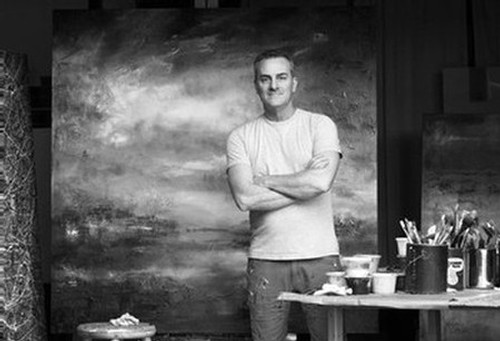James Frey
About the Artist
 Excerpt from: Between the Chaos and Calm
Excerpt from: Between the Chaos and Calm
"I visited James Frey’s McMinnville studio on a sunny day in mid-April. It’s at the end of half-mile driveway. There are no neighbors here. This, as I learn, seems to suit Frey...
…He never sketches his ideas. He holds them inside his head. When he starts a canvas, he just starts with the first brush stroke.
At the start, his strokes are big, bold. As the canvas evolves, they get smaller, more refined. As if connecting the pieces together. ‘If I start too cautious, the painting ends up cautious. It lacks energy. No life.’
He is an active painter, constantly moving, always on his feet. His brush strokes are aggressive, his arms and hands constantly moving. He works fast, preferring not to let one layer of paint fully dry before applying the next. Much like watching anyone who never stops moving, watching Frey paint can be exhausting.
‘I’ve always painted standing up. I’m sure there’s some subconscious thing going on where I think if I’m active, the work will somehow have more energy to it. I hate lifeless work. I always feel like I’m walking some imaginary line between too much chaos and too much control. It’s exhilarating when its right.’
Imagination is critical to Frey. He never paints on location. He never uses a picture. He only uses what’s in his head. Despite not trying to replicate reality, he has an uncanny ability to see things as they really are and capture something that people connect with."
Artist Bio:
James Frey began taking and developing his own photos at the age of 12. Three years later, he began working full-time as a newspaper photojournalist and by the age of sixteen became the youngest recipient to receive an award from the California newspaper association for his work. He continued to work as a photojournalist in order to pay his way through college. In his late twenties, Frey turned to painting and developed a passion for abstract expressionist works. His paintings of rich, deep hues and vibrant contrast create a powerful sense of color, shape, and energy. In order to create a greater tactile quality, at times he’ll incorporate vineyard cuttings, pinot noir skins and vineyard soil into a piece.
His paintings have been sold to collectors throughout North America. He also has work hanging in Great Britain, France, Sweden, Central America and Brazil.